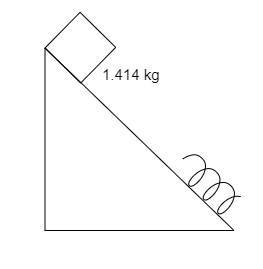
A block of mass

(A)
(B)
(C)
(D)
Answer
153.9k+ views
Hint The distance travelled by the block before it comes to rest can be determined by using the statement that the work done by the block will be equal to the potential energy stored by the spring, by equating the two formulas, then the distance is determined.
Useful formula:
The work done by the block will be equal to the potential energy stored by the spring is given by,
Where,
Complete step by step answer
Given that,
The mass of the block is given as,
The spring constant is given as,
The compression of the spring is given as,
Now,
The work done by the block will be equal to the potential energy stored by the spring is given by,
By substituting the mass of the block, acceleration due to gravity, the angle of the inclination, spring constant and the compression of the spring in the above equation (1), then the above equation (1) is written as,
From the trigonometry, the value of the
By cancelling the same terms in the above equation, then the above equation is written as,
By rearranging the terms in the above equation, then the above equation is written as,
By multiplying the terms in the above equation, then the above equation is written as,
By dividing the terms in the above equation, then the above equation is written as,
Hence, the option (D) is the correct answer.
Note Energy can neither be created nor destroyed. The energy can be transferred from one form of the energy to the other form of the energy. Here, the potential energy of the block is converted to the spring energy, because the block from the definite height will have the potential energy and then the block compresses the spring.
Useful formula:
The work done by the block will be equal to the potential energy stored by the spring is given by,
Where,
Complete step by step answer
Given that,
The mass of the block is given as,
The spring constant is given as,
The compression of the spring is given as,
Now,
The work done by the block will be equal to the potential energy stored by the spring is given by,
By substituting the mass of the block, acceleration due to gravity, the angle of the inclination, spring constant and the compression of the spring in the above equation (1), then the above equation (1) is written as,
From the trigonometry, the value of the
By cancelling the same terms in the above equation, then the above equation is written as,
By rearranging the terms in the above equation, then the above equation is written as,
By multiplying the terms in the above equation, then the above equation is written as,
By dividing the terms in the above equation, then the above equation is written as,
Hence, the option (D) is the correct answer.
Note Energy can neither be created nor destroyed. The energy can be transferred from one form of the energy to the other form of the energy. Here, the potential energy of the block is converted to the spring energy, because the block from the definite height will have the potential energy and then the block compresses the spring.
Latest Vedantu courses for you
Grade 11 Science PCM | CBSE | SCHOOL | English
CBSE (2025-26)
School Full course for CBSE students
₹41,848 per year
EMI starts from ₹3,487.34 per month
Recently Updated Pages
JEE Atomic Structure and Chemical Bonding important Concepts and Tips

JEE Amino Acids and Peptides Important Concepts and Tips for Exam Preparation

JEE Electricity and Magnetism Important Concepts and Tips for Exam Preparation

Chemical Properties of Hydrogen - Important Concepts for JEE Exam Preparation

JEE Energetics Important Concepts and Tips for Exam Preparation

JEE Isolation, Preparation and Properties of Non-metals Important Concepts and Tips for Exam Preparation

Trending doubts
JEE Main 2025 Session 2: Application Form (Out), Exam Dates (Released), Eligibility, & More

JEE Main 2025: Derivation of Equation of Trajectory in Physics

Electric Field Due to Uniformly Charged Ring for JEE Main 2025 - Formula and Derivation

Degree of Dissociation and Its Formula With Solved Example for JEE

Displacement-Time Graph and Velocity-Time Graph for JEE

Electrical Field of Charged Spherical Shell - JEE

Other Pages
JEE Advanced Marks vs Ranks 2025: Understanding Category-wise Qualifying Marks and Previous Year Cut-offs

JEE Advanced 2025: Dates, Registration, Syllabus, Eligibility Criteria and More

Motion in a Straight Line Class 11 Notes: CBSE Physics Chapter 2

Units and Measurements Class 11 Notes: CBSE Physics Chapter 1

NCERT Solutions for Class 11 Physics Chapter 1 Units and Measurements

NCERT Solutions for Class 11 Physics Chapter 2 Motion In A Straight Line




